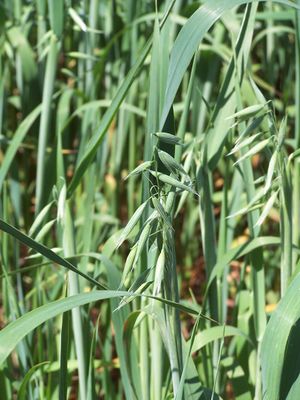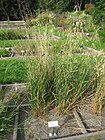Note: This is a project under development. The articles on this wiki are just being initiated and broadly incomplete. You can Help creating new pages.
Difference between revisions of "Avena sativa - Oat"
m (Prabhakar moved page Oat ( to Oat (Avena sativa)) |
|||
| (20 intermediate revisions by 2 users not shown) | |||
| Line 1: | Line 1: | ||
[[File:Avena sativa L.jpg|thumb|right|''Oat'']] | [[File:Avena sativa L.jpg|thumb|right|''Oat'']] | ||
| + | '''Avena sativa''' sometimes called the common oat. It is a species of cereal grain grown for its seed. While oats are suitable for human consumption as oatmeal and rolled oats, one of the most common uses is as livestock feed. | ||
| + | ==Uses== | ||
| + | {{Uses|Lower blood pressure}}, {{Uses|Bad cholesterol}}, {{Uses|Insomnia}}, {{Uses|Stress}}, {{Uses|Anxiety}}, {{Uses|Blood sugar}}, {{Uses|Aphrodisiac}}, {{Uses|Rashes}}, {{Uses|Sunburn}}. | ||
| − | + | ==Parts Used== | |
| + | {{Parts Used|Seeds}}, {{Parts Used|Dried stem}}, {{Parts Used|Leaf}}. | ||
| − | + | ==Chemical Composition== | |
| − | + | Per 100 g, the mature seed is reported to contain 374 calories, 11.0 g H20, 13.1 g protein, 6.1 g fat, 67.4 g total carbohydrate, 5.8 g fiber, 2.4 g ash, 59 mg Ca, 425 mg P, 4.6 mg Fe, 10 mg Na, 0.35 mg thiamine, 0.09 mg riboflavin, and 2.2 mg niacin. Generically, oat grains, with 78.7–95.2% DM (mean of 1650 cases = 89.1), contain on a zero moisture basis<ref name="chemical composition"/> | |
| − | |||
| − | + | ==Common names== | |
| − | Oat | + | {{Common names|kn=|ml=|sa=|ta=|te=|hi=|en=Common Oat}} |
| − | |||
| − | + | ==Properties== | |
| − | + | Reference: Dravya - Substance, Rasa - Taste, Guna - Qualities, Veerya - Potency, Vipaka - Post-digesion effect, Karma - Pharmacological activity, Prabhava - Therepeutics. | |
| + | ===Dravya=== | ||
| − | + | ===Rasa=== | |
| − | |||
| − | + | ===Guna=== | |
| − | == | + | ===Veerya=== |
| − | + | ===Vipaka=== | |
| − | == References == | + | ===Karma=== |
| + | |||
| + | ===Prabhava=== | ||
| + | |||
| + | ==Habit== | ||
| + | {{Habit|Culms erect}} | ||
| + | |||
| + | ==Identification== | ||
| + | ===Leaf=== | ||
| + | {{Leaf|Simple|Cauline|Ligule an eciliate membrane; 3-6 mm long. Leaf-blades 14-40 cm long 5-15 mm wide and Leaf-blade surface scaberulous}}<ref name="Leaf"/> | ||
| + | |||
| + | ===Flower=== | ||
| + | {{Flower|Unisexual|2-4cm long|Yellow|5-20|Ovary pubescent all over and Flowers Season is June - August}} | ||
| + | |||
| + | ===Fruit=== | ||
| + | {{Fruit|Caryopsis||Caryopsis with adherent pericarp, hairy all over. Hilum linear|Hairy all over|Few seeds}} | ||
| + | |||
| + | ===Other features=== | ||
| + | |||
| + | ==List of Ayurvedic medicine in which the herb is used== | ||
| + | |||
| + | ==Where to get the saplings== | ||
| + | ==Mode of Propagation== | ||
| + | {{Propagation|Seeds}}. | ||
| + | |||
| + | ==How to plant/cultivate== | ||
| + | Oats are an easily grown crop that succeeds in any moderately fertile soil in full sun<ref name="How to plant/cultivate"/> | ||
| + | |||
| + | ==Commonly seen growing in areas== | ||
| + | {{Commonly seen|Cultivated Beds}}, {{Propagation|Dry wasteland}}, {{Propagation|Meadows}}, {{Propagation|Cultivated ground}} | ||
| + | |||
| + | ==Photo Gallery== | ||
| + | <gallery class="left" caption="" widths="140px" heights="140px"> | ||
| + | File:Haverkorrels Avena sativa.jpg|Seeds | ||
| + | File:Haverplant Avena sativa.jpg|Whole herb | ||
| + | Avena sativa - Oslo botanical garden - IMG 8898.jpg|Flowers | ||
| + | Avena sativa 001.JPG|Leaves | ||
| + | |||
| + | </gallery> | ||
| + | |||
| + | ==References== | ||
<references> | <references> | ||
| − | <ref name=" | + | <ref name="chemical composition">[https://hort.purdue.edu/newcrop/duke_energy/Avena_sativa.html Chemistry]</ref> |
| + | |||
| + | <ref name="Leaf">[http://powo.science.kew.org/taxon/urn:lsid:ipni.org:names:391732-1 Plant description]</ref> | ||
| + | |||
| + | <ref name="How to plant/cultivate">[https://www.pfaf.org/user/Plant.aspx?LatinName=Avena+sativa Cultivation details]</ref> | ||
</references> | </references> | ||
| + | |||
| + | ==External Links== | ||
| + | * [https://www.mdidea.com/products/new/new03201.html Botanical Information of Oat Straw or Avena sativa] | ||
| + | * [http://eol.org/pages/1114783/details Avena sativa on encyclopedea of life] | ||
| + | * [https://gobotany.newenglandwild.org/species/avena/sativa/ Avena sativa on gobotony discover plants] | ||
| + | * [http://www.illinoiswildflowers.info/grasses/plants/oats.html Avena sativa on illinois wild flowers.info/] | ||
[[Category:Herbs]] | [[Category:Herbs]] | ||
| + | [[Category:Poaceae]] | ||
Latest revision as of 15:04, 17 March 2020
Avena sativa sometimes called the common oat. It is a species of cereal grain grown for its seed. While oats are suitable for human consumption as oatmeal and rolled oats, one of the most common uses is as livestock feed.
Contents
- 1 Uses
- 2 Parts Used
- 3 Chemical Composition
- 4 Common names
- 5 Properties
- 6 Habit
- 7 Identification
- 8 List of Ayurvedic medicine in which the herb is used
- 9 Where to get the saplings
- 10 Mode of Propagation
- 11 How to plant/cultivate
- 12 Commonly seen growing in areas
- 13 Photo Gallery
- 14 References
- 15 External Links
Uses
Lower blood pressure, Bad cholesterol, Insomnia, Stress, Anxiety, Blood sugar, Aphrodisiac, Rashes, Sunburn.
Parts Used
Seeds, Dried stem, Leaf.
Chemical Composition
Per 100 g, the mature seed is reported to contain 374 calories, 11.0 g H20, 13.1 g protein, 6.1 g fat, 67.4 g total carbohydrate, 5.8 g fiber, 2.4 g ash, 59 mg Ca, 425 mg P, 4.6 mg Fe, 10 mg Na, 0.35 mg thiamine, 0.09 mg riboflavin, and 2.2 mg niacin. Generically, oat grains, with 78.7–95.2% DM (mean of 1650 cases = 89.1), contain on a zero moisture basis[1]
Common names
| Language | Common name |
|---|---|
| Kannada | |
| Hindi | |
| Malayalam | |
| Tamil | |
| Telugu | |
| Marathi | NA |
| Gujarathi | NA |
| Punjabi | NA |
| Kashmiri | NA |
| Sanskrit | |
| English | Common Oat |
Properties
Reference: Dravya - Substance, Rasa - Taste, Guna - Qualities, Veerya - Potency, Vipaka - Post-digesion effect, Karma - Pharmacological activity, Prabhava - Therepeutics.
Dravya
Rasa
Guna
Veerya
Vipaka
Karma
Prabhava
Habit
Identification
Leaf
| Kind | Shape | Feature |
|---|---|---|
| Simple | Cauline | Ligule an eciliate membrane; 3-6 mm long. Leaf-blades 14-40 cm long 5-15 mm wide and Leaf-blade surface scaberulous |
Flower
| Type | Size | Color and composition | Stamen | More information |
|---|---|---|---|---|
| Unisexual | 2-4cm long | Yellow | 5-20 | Ovary pubescent all over and Flowers Season is June - August |
Fruit
| Type | Size | Mass | Appearance | Seeds | More information |
|---|---|---|---|---|---|
| Caryopsis | Caryopsis with adherent pericarp, hairy all over. Hilum linear | Hairy all over | Few seeds | {{{6}}} |
Other features
List of Ayurvedic medicine in which the herb is used
Where to get the saplings
Mode of Propagation
How to plant/cultivate
Oats are an easily grown crop that succeeds in any moderately fertile soil in full sun[3]
Commonly seen growing in areas
Cultivated Beds, Dry wasteland, Meadows, Cultivated ground
Photo Gallery
References
External Links
- Ayurvedic Herbs known to be helpful to treat Lower blood pressure
- Ayurvedic Herbs known to be helpful to treat Bad cholesterol
- Ayurvedic Herbs known to be helpful to treat Insomnia
- Ayurvedic Herbs known to be helpful to treat Stress
- Ayurvedic Herbs known to be helpful to treat Anxiety
- Ayurvedic Herbs known to be helpful to treat Blood sugar
- Ayurvedic Herbs known to be helpful to treat Aphrodisiac
- Ayurvedic Herbs known to be helpful to treat Rashes
- Ayurvedic Herbs known to be helpful to treat Sunburn
- Herbs with Seeds used in medicine
- Herbs with Dried stem used in medicine
- Herbs with Leaf used in medicine
- Herbs with common name in English
- Habit - Culms erect
- Index of Plants which can be propagated by Seeds
- Herbs that are commonly seen in the region of Cultivated Beds
- Index of Plants which can be propagated by Dry wasteland
- Index of Plants which can be propagated by Meadows
- Index of Plants which can be propagated by Cultivated ground
- Herbs
- Poaceae




